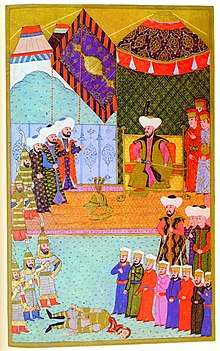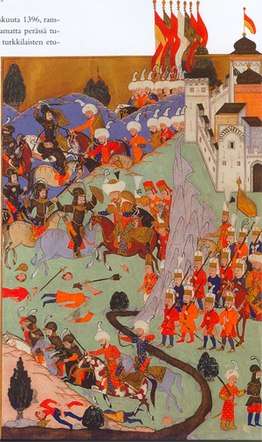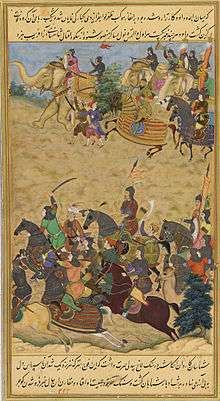Ghazi (warrior)
Ghazi (Arabic: غازي, ġāzī) originally referred to individuals who participated in ghazw (غزو, ġazw), meaning military expeditions or raiding. The latter term was applied in early Islamic literature to expeditions led by the Islamic prophet Muhammad, and later taken up by Turkic military leaders to describe their wars of conquest.[1]

In the context of the wars between Russia and the Muslim peoples of the Caucasus, starting as early as the late 18th century's Sheikh Mansur's resistance to Russian expansion, the word usually appears in the form gazavat (газават).[2]
In English language literature, the word often appears as razzia, a borrowing through French from Maghrebi Arabic. In modern Turkish, it is used to refer to veterans, and also as a title for Turkic champions such as Ertuğrul, Osman I, and Mustafa Kemal Atatürk.[3][4]
Ghazi as raid—razzia
In pre-Islamic Bedouin culture, ghazw[a] was a form of limited warfare verging on brigandage that avoided head-on confrontations and instead emphasized raiding and looting, usually of livestock (see cattle raiding). The Umayyad-period Bedouin poet al-Kutami wrote the oft-quoted verses: "Our business is to make raids on the enemy, on our neighbor and our own brother, in the event we find none to raid but a brother."[5][6] (Semi-institutionalized raiding of livestock herds was not unique to the Bedouins; the Soviet anthropologists adopted the Kazakh word barymta to describe similar practices of nomads in the Eurasian steppes[7], and similar dynamics were widespread in pre-feudal Ireland.) William Montgomery Watt hypothesized that Muhammad found it useful to divert this continuous internecine warfare toward his enemies, making it the basis of his war strategy;[8] according to Watt, the celebrated battle of Badr started as one such razzia.[9] As a form of warfare, the razzia was then mimicked by the Christian states of Iberia in their relations with the taifa states;[10] rough synonyms and similar tactics are the Iberian cavalgada and the Anglo-French chevauchée.[11]
The word razzia was used in French colonial context particularly for raids to plunder and capture slaves from among the people of Western and Central Africa, also known as rezzou when practiced by the Tuareg. The word was adopted from ġaziya of Algerian Arabic vernacular and later became a figurative name for any act of pillage, with its verb form razzier.
Historical development

Ghazi (Arabic: غازي, ġāzī) is an Arabic word, the active participle of the verb ġazā, meaning 'to carry out a military expedition or raid'; the same verb can also mean 'to strive for' and Ghazi can thus share a similar meaning to Mujahid or "one who struggles". The verbal noun of ġazā is ġazw or ġazawān, with the meaning 'raiding'. A derived singulative in ġazwah refers to a single battle or raid. The term ghāzī dates to at least the Samanid period, where he appears as a mercenary and frontier fighter in Khorasan and Transoxiana. Later, up to 20,000 of them took part in the Indian campaigns of Mahmud of Ghazni.
Ghāzī warriors depended upon plunder for their livelihood, and were prone to brigandage and sedition in times of peace. The corporations into which they organized themselves attracted adventurers, zealots and religious and political dissidents of all ethnicities. In time, though, soldiers of Turkic ethnicity predominated, mirroring the acquisition of Mamluks, Turkic slaves in the Mamluk retinues and guard corps of the caliphs and emirs and in the ranks of the ghazi corporation, some of whom would ultimately rise to military and later political dominance in various Muslim states.
In the west, Turkic ghāzīs made continual incursions along the Byzantine frontier zone, finding in the akritai (akritoi) their Greek counterparts. After the Battle of Manzikert these incursions intensified, and the region's people would see the ghāzī corporations coalesce into semi-chivalric fraternities, with the white cap and the club as their emblems. The height of the organizations would come during the Mongol conquest when many of them fled from Persia and Turkistan into Anatolia.
As organizations, the ghazi corporations were fluid, reflecting their popular character, and individual ghāzī warriors would jump between them depending upon the prestige and success of a particular emir, rather like the mercenary bands around western condottiere. It was from these Anatolian territories conquered during the ghazw that the Ottoman Empire emerged, and in its legendary traditions it is said that its founder, Osman I, came forward as a ghāzī thanks to the inspiration of Shaikh Ede Bali.
In later periods of Islamic history the honorific title of ghāzī was assumed by those Muslim rulers who showed conspicuous success in extending the domains of Islam, and eventually the honorific became exclusive to them, much as the Roman title imperator became the exclusive property of the supreme ruler of the Roman state and his family.
The Ottomans were probably the first to adopt this practice, and in any case the institution of ghazw reaches back to the beginnings of their state:
- By early Ottoman times it had become a title of honor and a claim to leadership. In an inscription of 1337 [concerning the building of the Bursa mosque], Orhan, second ruler of the Ottoman line, describes himself as "Sultan, son of the Sultan of the Gazis, Gazi son of Gazi… frontier lord of the horizons."
Ottoman historian Ahmedi in his work explain the meaning of Ghazi:[13]
A Ghazi is the instrument of the religion of Allah, a servant of God who purifies the earth from the filth of polytheism. The Ghazi is the sword of God, he is the protector and the refuge of the believers. If he becomes a martyr in the ways of God, do not believe that he has died, he lives in beatitude with Allah, he has eternal life.
The first nine Ottoman chiefs all used Ghazi as part of their full throne name (as with many other titles, the nomination was added even though it did not fit the office), and often afterwards. However, it never became a formal title within the ruler's formal style, unlike Sultan ul-Mujahidin, used by Sultan Murad Khan II Khoja-Ghazi, 6th Sovereign of the House of Osman (1421–1451), styled 'Abu'l Hayrat, Sultan ul-Mujahidin, Khan of Khans, Grand Sultan of Anatolia and Rumelia, and of the Cities of Adrianople and Philippolis.
Because of the political legitimacy that would accrue to those bearing this title, Muslim rulers vied amongst themselves for preeminence in the ghāziya, with the Ottoman Sultans generally acknowledged as excelling all others in this feat:
- For political reasons the Ottoman Sultans — also being the last dynasty of Caliphs — attached the greatest importance to safeguarding and strengthening the reputation which they enjoyed as ghāzīs in the Muslim world. When they won victories in the ghazā in the Balkans they used to send accounts of them (singular, feth-nāme) as well as slaves and booty to eastern Muslim potentates. Christian knights captured by Bāyezīd I at his victory over the Crusaders at Nicopolis in 1396, and sent to Cairo, Baghdad and Tabriz were paraded through the streets, and occasioned great demonstrations in favour of the Ottomans. (Cambridge History of Islam, p. 290)
Ghazi was also used as a title of honor in the Ottoman Empire, generally translated as the Victorious, for military officers of high rank, who distinguished themselves in the field against non-Moslem enemies; thus it was conferred on Osman Pasha after his famous defence of Plevna in Bulgaria and on Mustafa Kemal Pasha (later known as Mustafa Kemal Atatürk) for leading the defense against the Gallipoli campaign.
Some Muslim rulers (in Afghanistan) personally used the subsidiary style Padshah-i-Ghazi.
Muhammad's Ghazwa
Ghazwah, which literally means "campaigns", is typically used by biographers to refer to all the Prophet's journeys from Medina, whether to make peace treaties and preach Islam to the tribes, to go on ʽumrah, to pursue enemies who attacked Medina, or to engage in the nine battles.[14]
Muhammad participated in 27 Ghazwa. The first Ghazwa he participated in was the Invasion of Waddan in August 623,[15][16] he ordered his followers to attack a Quraysh caravan.[15]
Operationally
When performed within the context of Islamic warfare, the ghazw's function was to weaken the enemy's defenses in preparation for his eventual conquest and subjugation. Because the typical ghazw raiding party often did not have the size or strength to seize military or territorial objectives, this usually meant sudden attacks on weakly defended targets (e.g. villages) with the intent of demoralizing the enemy and destroying material which could support their military forces. Though Islam's rules of warfare offered protection to non-combatants such as women, monastics and peasants in that they could not be slain, their property could still be looted or destroyed, and they themselves could be abducted and enslaved (Cambridge History of Islam, p. 269):
- The only way of avoiding the onslaughts of the ghāzīs was to become subjects of the Islamic state. Non-Muslims acquired the status of dhimmīs, living under its protection. Most Christian sources confuse these two stages in the Ottoman conquests. The Ottomans, however, were careful to abide by these rules... Faced with the terrifying onslaught of the ghāzīs, the population living outside the confines of the empire, in the 'abode of war', often renounced the ineffective protection of Christian states, and sought refuge in subjection to the Ottoman Empire. Peasants in open country in particular lost nothing by this change.
- Cambridge History of Islam, p. 285
A good source on the conduct of the traditional ghazw raid are the medieval Islamic jurists, whose discussions as to which conduct is allowed and which is forbidden in the course of warfare reveal some of the practices of this institution. One such source is Averroes' Bidāyat al-Mujtahid wa-Nihāyat al-Muqtasid (translated in Peters, Jihad in Classical and Modern Islam: A Reader, Chapter 4).
Use in the modern era
In the 19th century, Muslim fighters in North Caucasus who were resisting the Russian military operations declared a gazawat (understood as holy war) against the Russian Orthodox invasion. Although uncertain, it is believed that Dagestani Islamic scholar Muhammad Yaragskii was the ideologist of this holy war. In 1825, a congress of ulema in the village of Yarag declared gazawat against the Russians. Its first leader was Ghazi Muhammad; after his death, Imam Shamil would eventually continue it.[17]
After the terrorist attacks on Paris in November 2015, the Islamic State group is said to have referred to its actions as "ghazwa".[18]
In modern Turkey, gazi is used to refer to veterans.[3] 19 September is celebrated as Veterans Day in Turkey.[19]
Notable examples
- Battal Ghazi, 8th century, Arab military commander
- Ahmad ibn Ibrahim al-Ghazi, 16th century general and Imam of the Adal Sultanate
- Belek Ghazi, Bey of Artuqids
- Danishmend Gazi 12th century, founder of Danishmendids
- Ertuğrul Gazi (13th century), leader of Kayı tribe, father of Osman I
- Ghazavat-i Sultan Murad, sixth Ottoman Sultan
- Gazi Chelebi (14th century), pirate and ruler of Sinop, Turkey
- Gazi Evrenos (1288–1417), Ottoman military commander
- Gazi Gümüshtigin, second ruler of Danishmendids
- Gazi-Husrev Beg, an Ottoman bey of Bosnian origin (1480–1541)
- Ghazi Khan, 15th century Baloch Chief from Dera Ghazi Khan, India
- Gazi Osman Pasha (1832–1897), Ottoman field marshal
- Ghazi Saiyyad Salar Masud (1014–1034), Ghaznavid military commander
- Gazi Saiyyed Salar Sahu (early 11th century), Ghaznavid military commander
- Haydar Ghazi, second wazir of Sylhet
- Ikhtiyaruddin Ghazi Shah, 14th century Sultan of Sonargaon
- Gazi Mustafa Kemal Atatürk (1881–1938), Turkish field marshal, first president of Turkey
- Osman Gazi (1299–1326), founder of Ottoman Empire
- Orhan Gazi (1281–1362), second Ottoman Sultan
- Sikandar Khan Ghazi, a military commander during the Conquest of Sylhet
Related terms
- Akıncı: (Turkish) "raider", a later replacement for ghāzī
- al-'Awāsim: the Syrio-Anatolian frontier area between the Byzantine and various caliphal empires
- ribāt: fortified convent used by a militant religious order; most commonly used in North Africa
- thughūr: an advanced/frontier fortress
- uc: Turkish term for frontier; uc beği (frontier lord) was a title assumed by early Ottoman rulers; later replaced by serhadd (frontier)
See also
- Gaza Thesis
- Jihad(ism)
- Fedayeen
- Janissary
- Spread of Islam
- Muslim conquests
- Battle of Hamra al-Asad
- Anatolian Beyliks
References
- Aboul-Enein, H. Yousuf and Zuhur, Sherifa,"Islamic Rulings on Warfare", Strategic Studies Institute, US Army War College, Diane Publishing Co., Darby PA, ISBN 1-4289-1039-5 pg. 6.
- The Background of Chechen Independence Movement II: The Sufi Resistance
- "Gazi - Türk Dil Kurumu | Sözlük". sozluk.gov.tr (in Turkish). Retrieved 2020-01-31.
- "Şehit ve Gazi farkı nedir". Arasındaki Fark (in Turkish). 2014-11-19. Retrieved 2020-01-31.
- Paul Wheatley (2001). The places where men pray together: cities in Islamic lands, 7th through the 10th centuries. University of Chicago Press. p. 11. ISBN 978-0-226-89428-7.
- A. J. Cameron (1973). Abû Dharr al-Ghifârî: an examination of his image in the hagiography of Islam. Royal Asiatic Society : [distributed] by Luzac. p. 9. ISBN 978-0-7189-0962-8.
- Anatoly Michailovich Khazanov (1984). Nomads and the outside world. Univ of Wisconsin Press. p. 156. ISBN 978-0-299-14284-1.
- William Montgomery Watt; Pierre Cachia (1996). A history of Islamic Spain. Edinburgh University Press. pp. 6–7. ISBN 978-0-7486-0847-8.
- William Montgomery Watt (1978). "Muhammad". In Ann Katherine Swynford Lambton; Bernard Lewis (eds.). The central islamic lands from pre-islamic times to the first world war. Cambridge University Press. p. 45. ISBN 978-0-521-29135-4.
- Cathal J. Nolan (2006). The age of wars of religion, 1000-1650: an encyclopedia of global warfare and civilization. Greenwood Publishing Group. p. 724. ISBN 978-0-313-33734-5.
- Cathal J. Nolan (2006). The age of wars of religion, 1000-1650: an encyclopedia of global warfare and civilization. Greenwood Publishing Group. p. 718. ISBN 978-0-313-33734-5.
- Lokman (1588). "Battle of Nicopolis (1396)". Hünernâme. Archived from the original on 2013-05-29.
- Paul Wittek, (2013), The Rise of the Ottoman Empire: Studies in the History of Turkey, thirteenth–fifteenth Centuries Royal Asiatic Society Books, p. 44
- Ahmed Al-Dawoody (2011), The Islamic Law of War: Justifications and Regulations, p. 22. Palgrave Macmillan. ISBN 9780230111608.
- Sa'd, Ibn (1967). Kitab al-tabaqat al-kabir, By Ibn Sa'd, Volume 2. Pakistan Historical Society. p. 4. ASIN B0007JAWMK.
GHAZWAH OF AL-ABWA* Then (occurred) the ghazwah of the Apostle of Allah, may Allah bless him, at al-Abwa in Safar (August 623 AC)
- Tabari, Al (2008), The foundation of the community, State University of New York Press, p. 12, ISBN 978-0887063442,
In Safar (which began August 4, 623), nearly twelve months after his arrival in Medina on the twelfth of Rabi' al- Awwal, he went out on a raid as far as Waddan
- Galina M. Yemelianova (2002). Russia and Islam: a historical survey. Palgrave Macmillan. p. 50. ISBN 978-0-333-68354-5.
- Ibrahim, Ayman S. (16 November 2015). "4 ways ISIS grounds its actions in religion, and why it should matter (COMMENTARY)". Washington Post. Retrieved 17 November 2015.
Further reading

- "Ghazw". Encyclopedia of Islam (CD-ROM v. 1.0 ed.). Brill. 1999.
- "Ghāzī". Encyclopedia of Islam (CD-ROM v. 1.0 ed.). Brill. 1999.
- Lewis, Bernard (1991). The Political Language of Islam. University of Chicago Press. ISBN 0-226-47693-6., p. 74
- Firestone, Reuven (1999). Jihad: The Origins of Holy War in Islam. Oxford University Press. ISBN 0-19-512580-0., p. 34
- Peters, Rudolph (1996). Jihad in Classical and Modern Islam: A Reader. Markus Wiener Publishers. ISBN 1-55876-109-8.
- Averroes, Bidāyat al-Mujtahid wa-Nihāyat al-Muqtasid
- Wittek, Paul; & Heywood, Colin, translator (2002). The Rise of the Ottoman Empire. Curzon Press. ISBN 0-7007-1500-2.CS1 maint: multiple names: authors list (link)
- Holt, Peter M., ed. (1970). The Cambridge History of Islam: Volume 1, The Central Islamic Lands. Cambridge University Press. ISBN 0-521-07567-X.CS1 maint: multiple names: authors list (link) CS1 maint: extra text: authors list (link)
- Robinson, Chase (2002). Islamic Historiography. Cambridge University Press. ISBN 0-521-62936-5.
- Rid, Thomas (2009). "Razzia: A Turning Point in Modern Strategy". Terrorism and Political Violence. 21 (4): 617–635. doi:10.1080/09546550903153449.
- Kaziev, Shapi. Imam Shamil. "Molodaya Gvardiya" publishers. Moscow, 2001, 2003, 2006, 2010. ISBN 978-5-235-03332-0
- Kaziev, Shapi. Akhoulgo. Caucasian War of 19th century. The historical novel. "Epoch", Publishing house. Makhachkala, 2008. ISBN 978-5-98390-047-9
- Mohammed Bamyeh (2006). "The Nomands of Pre-Islamic Arabia". In Dawn Chatty (ed.). Nomadic societies in the Middle East and North Africa: entering the 21st century. BRILL. pp. 33–49. ISBN 978-90-04-14792-8.
